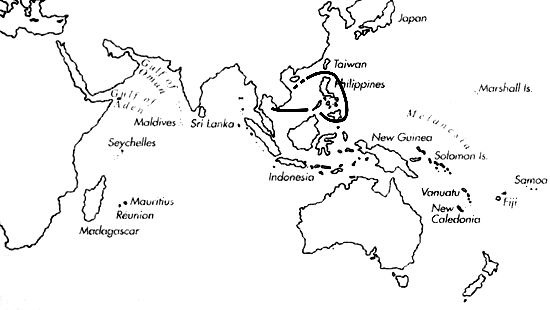Range: Philippines and South China Sea.
Description: Moderately large to large, solid. Last whorl usually conical or ventricosely conical, often pyriform; outline convex at adapical third to two-thirds, straight to concave below. Shoulder angulate. Spire usually low, outline concave. Larval shell of about 3.5 whorls, maximum diameter 0.9-1.0 mm. First 2.5-4.5 postnuclear whorls tuberculate. Teleoconch sutural ramps flat, with 1-2 increasing to 4-6 spiral grooves. Last whorl with weak spiral ribs and/or ribbons at base.
| Shell Morphometry | ||
|---|---|---|
| L | 55-91 mm | |
| RW | 0.30-0.57 g/mm | |
| (L 55-85 mm) | ||
| RD | 0.56-0.71 | |
| PMD | 0.80-0.89 | |
| RSH | 0.02-0.13 | |
Ground colour white. Last whorl with brown axial blotches on adapical three-fourth and an incomplete spiral band of the same colour on each side of centre. Central ground-colour band usually continuous; subcentral pattern elements may be absent. Base usually white, occasionally variably tinged with cream. Larval whorls white. Teleoconch sutural ramps with irregularly set brown axial markings. Aperture white.
Periostracum olive, thin, translucent to opaque, with axial threads and widely spaced tufted spiral lines on last whorl; thickness increases towards base and tufts are stronger at base and shoulder.
Habitat and Habits: In 100-240 m.
Discussion: For comparisons with the similar C. sugimotonis and C. sieboldii, see the DISCUSSIONS of those species. C. tribblei has a similar colour pattern but attains larger size (to 138 mm), generally has a narrower last whorl (RD 0.47-0.61) with an almost straight rather than sigmoid outline; its late whorls have carinate shoulders and the spiral sculpture is heavier on its last whorl. C. eximius is considerably smaller, its spire generally higher (RSH up to 0.26), its periostracum lacks tufted spiral lines and its last whorl pattern often contains dashed and dotted spiral lines. C. malacanus differs in its heavier shell, usually higher spire (RSH to 0.17), less pyriform last whorl, carinate later whorls, and its smooth periostracum.

C. lenavati range map
This section contains verbatim reproductions of the accounts of 316 species of Conus from the Indo-Pacific region, from Manual of the Living Conidae, by Röckel, Korn and Kohn (1995). They are reproduced with the kind permission of the present publisher, Conchbooks.
All plates and figures referred to in the text are also in Röckel, Korn & Kohn, 1995. Manual of the Living Conidae Vol. 1: Indo-Pacific Region.
The range maps have been modified so that each species account has it own map, rather than one map that showed the ranges of several species in the original work. This was necessary because each species account is on a separate page on the website and not confined to the order of accounts in the book.